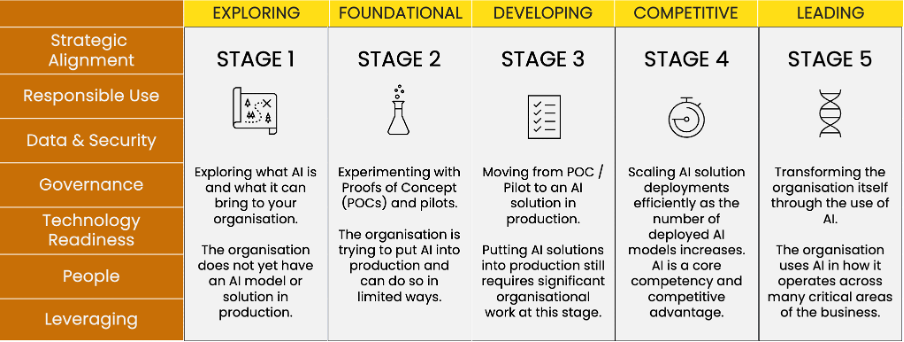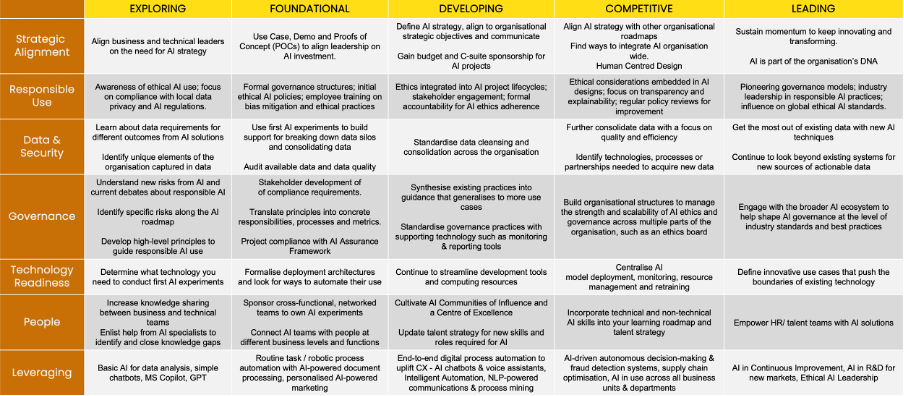How do you measure AI maturity in your organisation? With the advent of Generative AI, the business world is changing faster than anyone had thought possible.
The integration of Artificial Intelligence (AI) is fast becoming a crutch for organisations seeking to enhance efficiency, drive innovation, and gain a competitive edge. However, simply adopting AI technologies is not enough.
Operationalising AI is complex. Many organisations either overlook challenges in Strategy, Responsible Use, Data, Technology, People, or Governance, or they over-prepare in one area. Both mistakes can hinder progress. Delays can be critical in maintaining a competitive advantage with AI.
However, there are rewards for persevering. Leading organisations have already seen dramatic transformations through AI, reaping significant benefits for their bottom line, employee & customer experience. The key is to begin with one use case at a time and remain committed until the organisation can scale operations and explore new products, services, and business models for transformative impact.
To truly harness the potential and realise value from AI, organisations must understand where they are today in terms of AI maturity. Once you have clarity on where you’re at, the next step is to build a roadmap to get you to where you want to be.
Ensuring that your AI initiatives are strategically aligned with your organisational priorities is crucial for driving impactful results, maximising return on investment, and ensuring that technological advancements support and enhance your core business objectives.
Not every organisation will have ambitions of leading the pack in terms of AI, but every organisation should at the very least clearly and decisively understand their posture on AI, which will inform your strategic objectives, and employee policies and ensure that you have the appropriate data security and privacy guardrails in place.
Most importantly, understanding your organisation’s posture on AI and communicating it effectively throughout the organisation should be at the top of every organisation’s list of priorities.
Measuring AI maturity provides a clear picture of how well an organisation is leveraging AI, identifying strengths, uncovering gaps, and guiding strategic investments. By evaluating key dimensions such as strategy, data management, technology infrastructure, talent, and ethical considerations, you can systematically enhance your AI capabilities, ensuring they are not only keeping pace with technological advancements but also driving sustainable growth and operational excellence.
In essence, assessing AI maturity is a vital step in transforming AI from a buzzword into a tangible, impactful asset that can shape the future of your organisation.
Where are you on your AI Journey?
AI Maturity Models

At Customer Science Group / CX:AI, we have developed our own AI maturity assessment model that considers the seven dimensions and five stages of maturity shown above.
There are of course several other maturity models out there that provide frameworks to assess your AI maturity. Notable ones include:
Gartner’s AI Maturity Model: Categorises organisations into five stages – Awareness, Active, Operational, Systematic, and Transformational.
Forrester’s AI Maturity Model: Includes four stages, Novice, Experimenter, Practitioner and Expert.
Deloitte’s AI Maturity Model: Focuses on strategy, talent, data, technology, and operations to categorise maturity levels from Experimenters to Transformers.
Element AI’s AI Maturity Model: highlights five dimensions: strategy, data, technology, people, and governance. The maturity is defined across five levels: exploring, experimenting, formalising, optimising, and transforming.
Google’s AI Maturity Model: is Structured around four themes, People, Data, Technology and Process.
Microsoft’s AI Maturity Model: is designed to guide organisations through their AI journey by focusing on the dimensions of Strategy, Culture, Data, Technology, Capabilities & Governance.
Despite the availability of these existing models, we developed our own for several reasons:
- Tailored to Specific Needs.
- Industry-Specific Requirements: Our customers tend to have unique needs that are not fully addressed by generic models.
- Customised Metrics: Our customers often have specific metrics or evaluation criteria that align more closely with their business goals and client expectations.
- Addressing Gaps in Existing Models.
- Comprehensive Coverage: We have blended key aspects from existing models as we wanted a model that fully covered aspects that we deemed critical, such as specific ethical considerations, sustainability, and client-centric approaches.
- Flexibility and Adaptability: Our custom model is more flexible and adaptable to evolving technologies and market demands.
- Client-Specific Customisation
- Client Engagement: Our custom model can be tailored to the specific capabilities of our clients, providing more relevant and actionable insights.
Detailed Assessments: We can offer more granular assessments that are directly applicable to a client’s context, leading to more effective and practical recommendations.
- Focus on Unique Aspects.
- Ethical Behaviour and Sustainability: Given our emphasis on ethical behaviour and sustainability, our model prioritises these elements more heavily.
- Customer Experience and Service Design: Reflecting our unique experience in customer experience and service design, our AI model places a stronger emphasis on these areas.
- Strategic Partnerships and Collaborations
- Leverage Partnerships: With strong partnerships (e.g., with UiPath), our model incorporates insights and best practices from these collaborations, enhancing its relevance and effectiveness.
Customer Science Group’s AI Maturity Model

By comprehensively assessing these factors, your organisation can determine your AI maturity level and identify areas for improvement to advance your AI capabilities.
Get in touch below if you’d like assistance with assessing your AI maturity and the development of an AI strategy.
